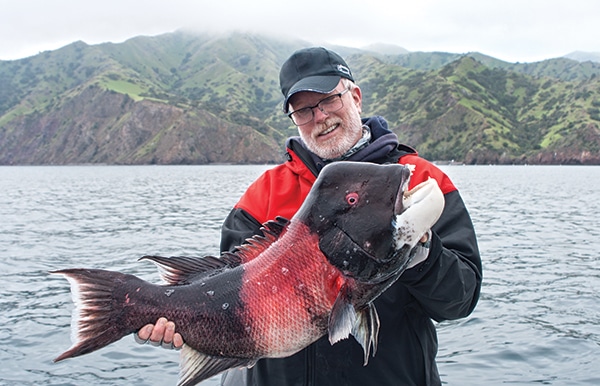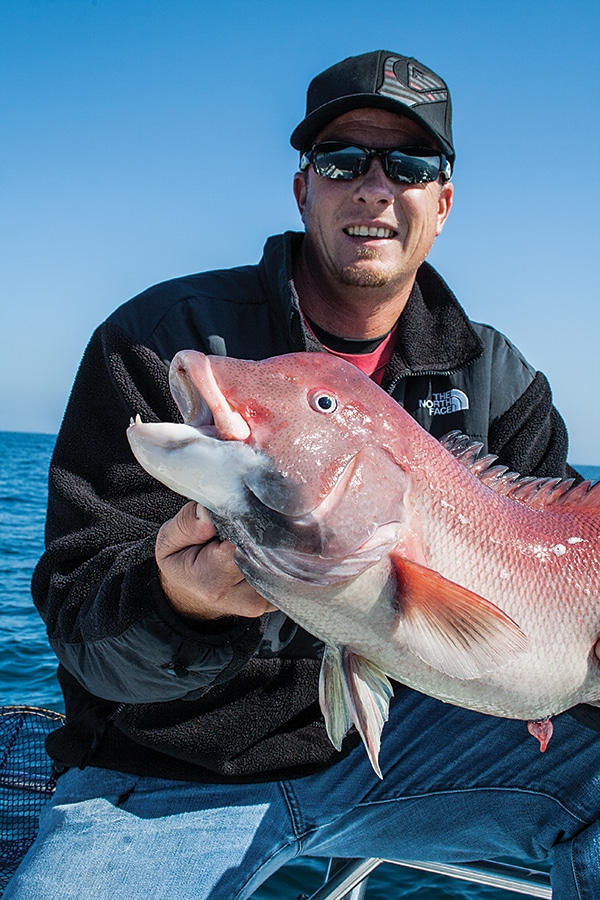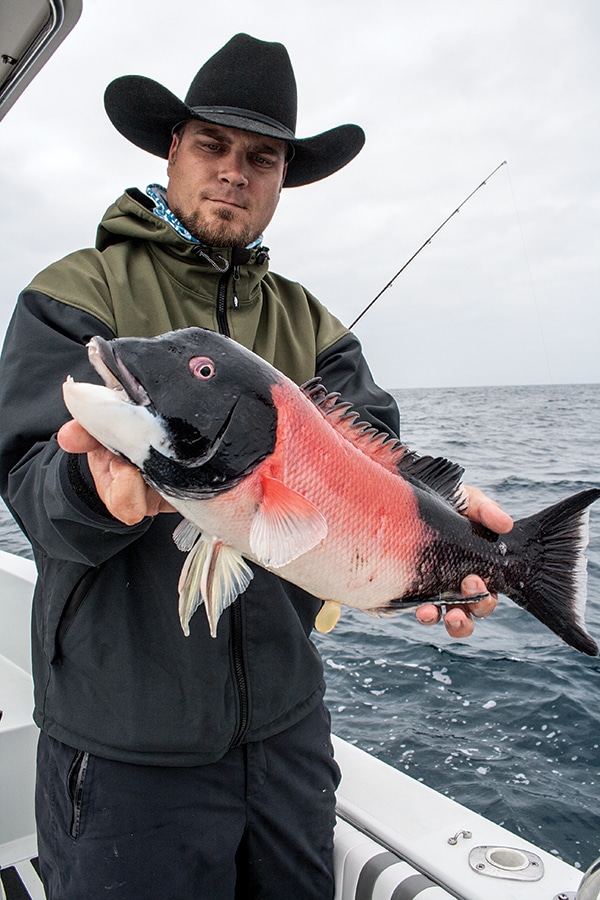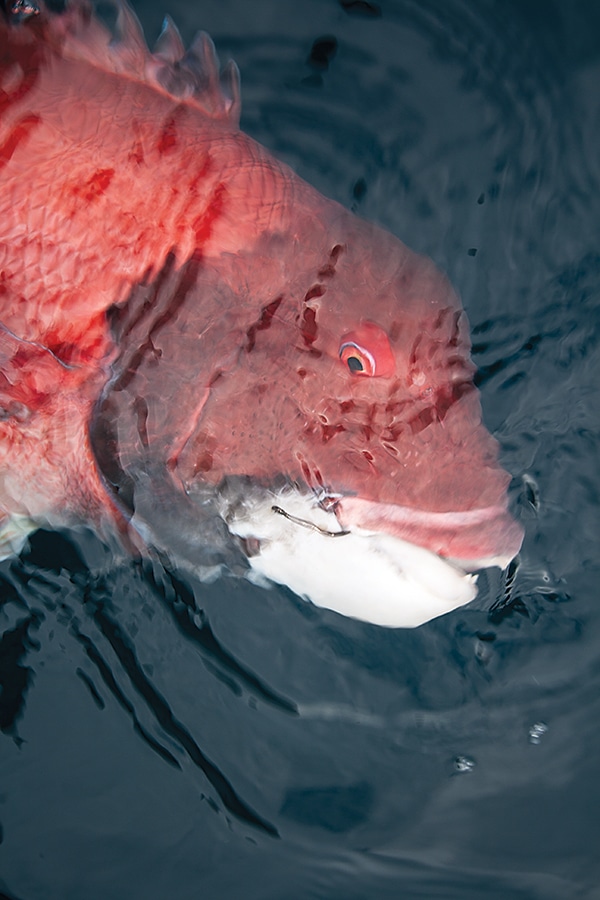
As soon as the squid bait reached the craggy hulk 150 feet below, I felt a solid rap. Then the rod tip bowed over. Seconds later, I set the hook, and the first powerful dive of the fish pinned me to the rail. With the drag locked tight, it was mano a pescado, white knuckles straining to hold on as the brute dug for the wreck.
Eventually, I was able to raise the rod above horizontal and gain line as the fish uncorked violent head shakes and dove repeatedly, wrenching me back to the rail again and again. From the depths emerged the distinctive black-and-red of one of the West Coast’s most striking game fish — the California sheephead. After a quick weight check –– 25 pounds –– and a few photos, we released the knot-headed male, which local anglers affectionately call a “goat.”
With a life cycle that has each fish morphing from female to male as it ages, this Pacific member of the wrasse family displays magnificent colors. Younger females have an overall light-red hue, while older males develop a black head and tail with a bright-red band between, and a white chin, with the big ones sporting a hump on their foreheads. The state record by an angler in California is 30 pounds, 8 ounces, caught off Newport Beach in 2009 from a kayak. The spear-fishing record is 40 pounds, 7 ounces. The difference between the two records says a lot about how tough it is to land these fish with a rod and reel. Big goats possess incredible power and live in snag-infested, line-slicing habitats — what I like to call
bad neighborhoods.
Sheephead range from Point Conception in the north, to far below the Mexican border in the south. No matter where you fish along the Southern California coast or offshore islands, the key is to target rocks, kelp lines, reefs and wrecks — sheephead love structure. But if you want to hook a trophy, wrecks and isolated rocky outcroppings are the best hunting grounds. This is where the big goats graze, and fall months offer the hottest action of the year.
Wreck Rationale

Unlike coastal kelp beds or the rocky island shores, wrecks and isolated rock piles don’t support big numbers of sheephead. Rather, such spots are often dominated by one to three home-guard goats, usually large fish that have chased away smaller sheephead to have the food supply to themselves.
Like other wrasses, sheephead nip away at the creatures that cling to rocks and wrecks. Equipped with a formidable set of bucked-toothed chompers and powerful jaws, they handily crush barnacles, mussels, clams, snails and crabs. Their favorite foods include shrimp, octopus and squid, but they will also eat a sardine or topsmelt.
If you’re targeting big sheephead, pick a wreck or outcropping in 60 to 175 feet of water. It has been my experience that structure in less than 60 feet does not produce trophy goats, nor have I caught many sheephead at all in water more than 200 feet deep.
Fish ’Em Right

Sheephead seldom strike aggressively, and most commonly tap at the bait before wolfing it down. Proper tackle allows you to sense subtle bites, while providing the stopping power and lift to wrestle a big goat away from structure. Additionally, low-stretch braided line helps you set the hook with authority to better control the fish once the battle begins.
The key to getting bit is to keep the sinker on or very close to the structure. Sheephead feed mainly on critters clinging to the rocks or wreck. While they will swim up a few feet to investigate a possible meal, they won’t stray too far from the dinner table.
A simple trick helps save the leader when you snag a weight on the bottom: Tie an overhead knot just above the sinker to create a weak spot that breaks, saving you the hassle of replacing the entire rig. All you do is tie in a new end loop, another overhand knot, and loop on a new sinker.
Some of the best baits for sheephead include whole squid (live or frozen) and baby octopus (which you can buy frozen in Asian fish markets). Pin either bait a couple of times with the hook to keep sheephead from pecking it off. Once you feel the solid rap of a goat, wait until the fish bends the rod before setting the hook.

Sheephead have a bunch of teeth, crushers, and a leathery mouth and lips, so sinking a hook requires considerable force, especially when fishing deeper than 100 feet. The sweep of an 8-foot rod helps, as does a sharp hook and braided line. Keep the drag as tight as possible to prevent the fish from pulling line off the reel.
The winner of the fight is usually determined in the first five to 10 seconds of the battle. Pull the fish 10 feet away from the structure, and all that’s left are some fierce head shakes and last-ditch lunges for the bottom. Fail to get him away from snags quickly, and there’s a good chance you’ll lose.
While there are seasonal closures on sheephead in Southern California, I like to release every goat we catch. I don’t consider them particularly good table fare. Yet a live-fish commercial market has emerged for California sheephead — one that could significantly impact this species. And so I like to do everything in my power to make sure my children and their children will have goats to bust a long time into the future.









